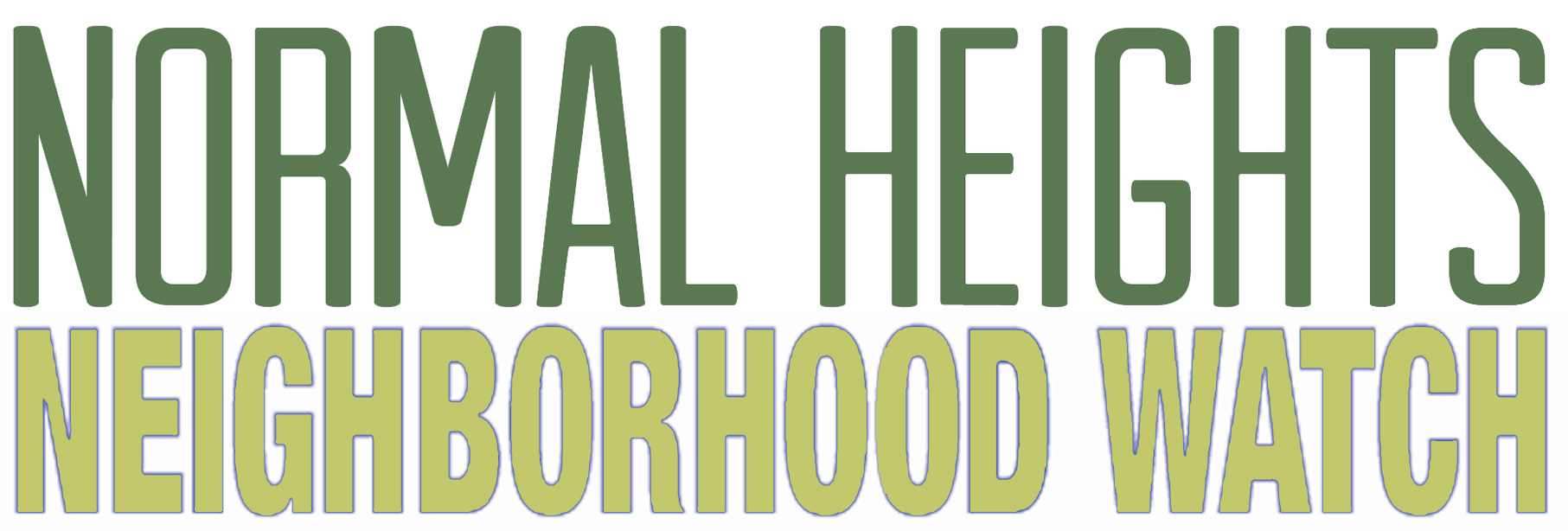Neighborhood Watch programs are one of the most effective crime prevention programs in the nation. It brings the citizens of Normal Heights and law enforcement together to deter crime and make our communities safer. Neighborhood Watch enlists the active participation of residents in cooperation with law enforcement to reduce crime, solve problems, and improve the quality of life in your area. In it you will get to know and work with your neighbors, and learn how to:
-Recognize and report crimes and suspicious activities
-Protect yourself, your family, and your property
-Protect your neighbor’s family and property, and
-Identify crime and disorder problems in your area and work with SDPD personnel to solve them
Background
In 1972 The National Sheriff’s Association organized the National Neighborhood Watch Program. This pilot program was funded by the Law Enforcement Assistance Administration of the U.S. Department of Justice and was designed to enlist the participation of citizens with law enforcement to help reduce and prevent crime. The Normal Heights Neighborhood Watch is most likely the first to see a crime and call for help, and are in the best position to:
-Report code violations, unsafe street conditions, etc. that degrade the quality of life in your area
-Take property owners to small claims court to abate nuisances
-Keep your block clean and free of graffiti, and provide a safe environment for your children
What is Neighborhood Watch?
It is a crime prevention program that enlists the active participation of residents in cooperation with law enforcement to reduce crime, solve problems, and improve the quality of life in your area. In it you will get to know and work with your neighbors, and learn how to:
-Recognize and report crimes and suspicious activities,
-Protect yourself, your family, and your property,
-Protect your neighbor’s family and property, and
-Identify crime and disorder problems in your area and work with SDPD personnel to solve them.
How can I participate?
By becoming a Block Captain, a Block Co-captain, or Watch Member.
Watch Members are residents who are diligent in keeping their eyes and ears open for any suspicious or criminal activity. They know their neighbors and have contact information so they are quickly able to alert neighbors to suspicious behavior.
Block Captains (usually one captain per 40 homes) compile a membership list, develop an area map with home addresses and phone numbers. If interested, the block group can purchase watch signs, and the Block Captain collects money for that purpose.
Block Co-Captains assist the Block Captains with a divison of responsibilities, depending on the size of the block or area. While Co-Captains are not required, they can be very helpful.
How do I build my Neighborhood Watch?
Subsequent meetings and activities
Meetings of the whole group should be held at least once a year. They can be held more often if there is information to be distributed and discussed, a problem to address, or a special event to be planned and held. The key to keeping a Neighborhood Watch group active is maintaining interest over time and communicating with members.
Meetings can be scheduled to discuss specific crime prevention or other topics. The SDPD can also provide officers to talk on domestic violence, workplace violence, gangs, child and adult abuse, alcohol and drug abuse, identity theft, landlord/tenant relations, bike safety, homeland security, etc. Check with your CRO first and then call SDPD Media Services at (619) 531-2900 to request a talk. Meetings can also be scheduled to address a serious incident in the area, or two or more less-serious incidents of the same type. Problem solving usually proceeds in the following steps:
Definition
What is the problem? Some examples are car break-ins and thefts, home burglaries, speeding, unlicensed solicitors, graffiti, panhandling, and trash dumping.
Analysis
What are the common elements of the problem? They could be time of day, location, kinds of offenders and victims, kinds of targets, access to targets, methods of defeating security measures, etc.
Response
How can the problem be addressed? What can be done to prevent recurrence or reduce the damage if it does recur? What agencies or organizations are responsible and should help in solving the problem? What are the best things to do for short-and long-term results?
Assessment
Did the problem go away? Was the damage reduced? If not, what else should be done?
Special Events
Special events are another good way to keep the group active. The following are some possibilities:
-Neighborhood walks to identify potential crime and disorder problems
-Socials, e.g., parties or potluck dinners
-Cleaning streets, vacant lots, canyons, parks, etc.
-Graffiti paint outs
-Fund raising to buy signs, e.g., by collecting recyclables
-Bicycle safety and licensing rodeo
-Painting address numbers on curbs and alley fences or garages
Contact
Mid-City Divison Police Station
4310 Landis St. SD 92105
(619) 516-3000

